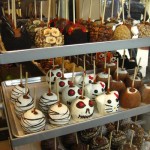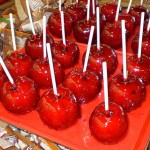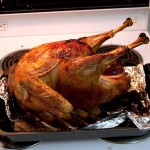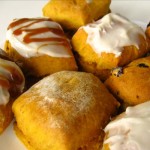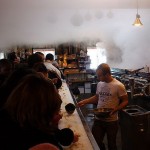 Vi avverto, questa e’ una maialata. Mi piacerebbe dilungarmi sulle paste Canadesi, che hanno una passione sfrenata per i dolci, ma questa invenzione le batte tutte. La Bever Tail. Che non e’ una vera coda di Castoro, ma ne ha la forma. Pastafrolla fritta (non tipo bombolone, molto piu’ fritta e solida) con sopra una varieta’ di cose, come nutella e banane, burro di sciroppo d’acero, cioccolata e noci, semplice con zucchero a velo o con sciroppo d’acero etc. Viene servita calda dalle bancarelle posizionate strategicamente nei posti turistici, quando non sai dire di no a queste bombe caloriche! Ma tranquilli, una pasta di queste e’ lunga circa 25 cm, e dunque ne basta una sola per tutta la famiglia!
Vi avverto, questa e’ una maialata. Mi piacerebbe dilungarmi sulle paste Canadesi, che hanno una passione sfrenata per i dolci, ma questa invenzione le batte tutte. La Bever Tail. Che non e’ una vera coda di Castoro, ma ne ha la forma. Pastafrolla fritta (non tipo bombolone, molto piu’ fritta e solida) con sopra una varieta’ di cose, come nutella e banane, burro di sciroppo d’acero, cioccolata e noci, semplice con zucchero a velo o con sciroppo d’acero etc. Viene servita calda dalle bancarelle posizionate strategicamente nei posti turistici, quando non sai dire di no a queste bombe caloriche! Ma tranquilli, una pasta di queste e’ lunga circa 25 cm, e dunque ne basta una sola per tutta la famiglia!
Category Archives: CIBO
le mele candite : Caramel Apples! [en]
[en]
Who has not seen in movies of apples on a stick covered in frosting? But above all, who has tried them? Here you will find them quite frequently, especially in the chain of chocolate Rocky Mountains, where it can be found to suit all tastes and with many decorations. I have not yet attempted, I think they call caries on the teeth, but who knows ‘, maybe one day I’ll try!
[it]
Chi non ha visto nei film le mele su uno stecco ricoperte di glassa? Ma soprattutto, chi le ha provate? Qui si trovano abbastanza frequentemente, specialmente nella catena di cioccolaterie Rocky Mountains, dove se ne possono trovare di tutti i gusti e con molte decorazioni originali. Io non mi sono ancora attentata, mi sa che chiamino carie sui denti, ma chissa’, magari un giorno le provero’!
Thanksgiving: il giorno del Ringraziamento [en]
[en]
Often seen in the television series, in autumn there ‘s always the Thanksgiving episode. Families gather together, similarly to Christmas day, to make a lunch-dinner in the middle of the afternoon, where the roasted turkey is main course. In Canada it is celebrated a month earlier than in America, on the second Monday of October. That’s ’cause Canada is colder and Thanksgiving is a holiday that celebrates the end of the harvest, by which time the temperatures start to become more rigid (In fact, during these days, autumn’s colors are starting to be visible also in the city).
Now I’ll do a little ‘menu’: as starter a soup of winter vegetables such as leek and pumpkin. As main course, stuffed roast turkey (the fillings are of many types), which takes about 24 hours of preparation, and often served with gravy, a kind of mixture resulting from the fatty portions of the waste turkey, or a lighter option is sauce of apples and cranberries. As a side salad and pumpkin squash/ potatoes/ yams or sweet potatoes roasted or mashed. To complete, pumpkin pie (see previous post).
Personally, the great thing about turkey is that is so big that then we have lunch for a week, and then we get creative with a variety of turkey sandwiches and side dishes of potatoes. Also, with all the leftovers, we always do a lot of broth to freeze for future use. In short, as for the pig, of the turkey you don’t throw anything away!
A couple of curiosities : in Canada, the weekend of thanksgiving, marks the main outputs of movies at the cinema, a bit as in Italy for Christmas period. In addition to Toronto, it’s Honest Ed’s 25th year (at the intersection of Bathurst and Bloor) where they donate free turkey and fruitcake to new Canadian immigrants.
[it]
Lo avrete visto spesso nelle serie televisive, in autunno c’e’ sempre la puntata che riguarda il Thanksgiving. Le famiglie si riuniscono un po’ come si fa a Natale, per fare un pranzo-cena nel bel mezzo del pomeriggio, dove il Tacchino arrosto e’ la portata principale. In Canada si festeggia un mese prima che in America, infatti cade durante il secondo Lunedi’ di Ottobre. Questo perche’ in Canada fa piu’ freddo che negli USA e il Thanksgiving e’ una festa che celebra la fine del raccolto, quando ormai le temperature iniziano a diventare piu’ rigide (Infatti proprio in questi giorni iniziano a notarsi i colori dell’autunno anche in citta’).
Adesso faccio un po’ di menu’: per iniziare una zuppa di verdure invernali, come porro e zucca. Poi come secondo e piatto principale, il tacchino arrosto ripieno (i ripieni sono di moltissimi tipi), che prende praticamante 24 ore di preparazione, e spesso viene servito con salsa gravy, una specie di miscuglio derivante dalle parti grasse degli scarti di tacchino, oppure salsa di mele e cramberries. Come contorno vengono serviti insalate e zucche squash, patate, yam o patate dolci arrosto oppure in pure’. Per completare torta pie di zucca (Vedi post precedente).
Personalmente la cosa bella del tacchino e’ che e’ talmente grosso che poi abbiamo pranzi per una settimana, e poi ci sbizzariamo con una varieta’ di panini al tacchino con contorni di patate. Inoltre con tutti i rimasugli facciamo sempre un sacco di brodo che congeliamo per usi futuri. Insomma, come del maiale, del tacchino non si butta via niente!
un paio di curiosita’: in Canada il weekend del thanksgiving segna le uscite principali dei film al Cinema, un po’ come in Italia per il periodo Natalizio. Inoltre a Toronto, e’ il 25esimo anno che Honest Ed (all’incrocio di Bathurst e Bloor) da gratis il tacchino e torta di frutta ai nuovi emigranti Canadesi.
Pane e torta di Zucca: Pumpkin pie … and bread! [en]
[en]
Finally Autumn starts for real. Not that summer here sucks, but October is one of the most interesting months to experience in Canada. Today I’ll talk about how pumpkins become really special over here. You see them everywhere, like decorations shop windows, or products in supermarkets, as it recall a number of traditions. Indeed, it’s almost Thanksgiving day (I will return on this topic on Monday) and therefore, in addition to the classic Pumpkin Pie (which I found a recipe that I think faithful to those which I tried already, at this address ) you can find specialties in bakery stores like Pumpkin Bread. In particular, I found the Pumpkin scone in an Australian chain Cobs Bread (or Bakers Delight), which I liked very much: they’re soft and lightly sweet! Well, I finally figured out why I never liked the pumpkin ravioli: the flavor goes perfectly with sweets!
[it]
Finalmente inizia per davvero l’autunno. Non che l’estate ci faccia schifo, ma Ottobre e’ uno dei mesi piu’ interessanti da vivere in Canada. Oggi parlero’ della zucca, perche’ qui diventa un elemento davvero speciale. Se ne vedono da tutte le parti, come decorazioni delle vetrine dei negozi, o prodotti nei supermercati, perche’ richiama diverse tradizioni. Infatti qui si stanno tutti preparando alla festa del Giorno del Ringraziamento (ne parlero’ lunedi’) e dunque, oltre alla classica Pumpkin Pie (o Torta di zucca, di cui ho trovato una ricetta che mi pare fedele a quelle che mangio qui) si possono trovare specialita’ nei forni -bakery- quali Pane di zucca. In particolare ho trovato le Pumpkin scone alla catena australiana Cobs Bread, che mi sono piaciute moltissimo. Ho trovato un paio di ricette online, una per le pagnotte e una per il pane di zucca (non sono affiliata con nessuno di questi siti, dunque sentitevi liberi di ricercare il web per altre ricette!). Insomma, ho finalmente capito perche’ non mi sono mai piaciuti i tortelli di zucca: quel sapore si sposa perfettamente con i dolci!
Cabane à sucre: il ristorante dello sciroppo [en]
[en]
Cabane à sucre, or Sugar Shack, is a tradition that mainly concerns the province of Quebec, a kind of festival of maple syrup harvest that occurs at the end of the snow season, between March and April. I knew that the maple is an important tree in Canada, might be the leaf in the middle of the flag, might be that when you visit Canada there are vast expanses of forests lose-eye, the fact is that these trees are not just beautiful in autumn, but they are the famous for the maple syrup. I got invited a couple of times. “We go to the Cabane a Sucre, it’s outside Montreal, do not eat, you’ll eat all based maple syrup, then we stay there, we’ll do some games and dance” … Dunno, ok, let’s go. I don’t have a sweet tooth, so I did not understand how to eat lunch with maple syrup. When you go to the Cabane à Sucre (which is not ‘the gingerbread house of Hansel & Gretel, but a restaurant made as a chalet) you discover that syrup is not just about pancakes, but also to flavor soups, roast pork, ham, bacon, potatoes and lentils! Not only, in the back of the restaurant you can get a lollipop obtained from hot poured syrup on snow and pulled up with a stick! it’s over all a very fun and unique experience, if you pass in Quebec and Northern Ontario at that time of year, try it!
[it]
La Cabane à sucre, o Sugar Shack, e’ una tradizione che riguarda soprattutto il Quebec, una specie di sagra di fine raccolta che avviene alla fine della stagione nevosa, fra Marzo e Aprile. Io lo sapevo che l’acero e’ un albero importante in Canada, sara’ per la foglia in mezzo alla bandiera, sara’ che quando visiti il Canada ci sono delle distese immense di foreste a perdi-occhio, fatto sta che questi alberi non sono solo belli in autunno, ma ci fanno il famoso sciroppo d’acero. Mi invitarono un paio di volte. “Andiamo alla Cabane a Sucre, si fuori da Montreal, non mangiare che mangi la’ tutto a base di scirppo d’acero, poi si sta la’, si balla ci sono dei giochi”… boh, ok, andiamo. Io non sono appassionata di dolci, dunque non capivo come si faccia il pranzo a base di sciroppo d’acero. Quando vai alla Cabane à Sucre (che non e’ la casetta di marzapane di Hansel & Gretel, ma un ristorante fatto a chalet) scopri che lo sciroppo non serve solo sui pancakes, ma anche a insaporire zuppe, arrosto di maiale, prosciutto cotto, pancetta, patate e lenticchie! E non e’ finita qui, nel retro del ristorante puoi farti un lecca-lecca ottenuto dallo sciroppo colato a caldo sulla neve e tirato su con uno stecchino! Insomma, e’ un’esperienza molto divertente e singolare, se passate in Quebec o Nord Ontario in questo periodo, provatelo!
